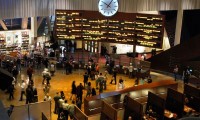See also:
THE SKED NETFLIX REVIEW: “Arrested Development” (Episodes 1-3)
THE SKED NETFLIX REVIEW: “Arrested Development” (Episodes 4-7)
THE SKED NETFLIX REVIEW: “Arrested Development” (Episodes 8-11)
It turned out that the one thing not to expect from Season 4 of ARRESTED DEVELOPMENT was an ending. Rather than build its intricately plotted season toward a carefully constructed resolution, Season 4 ran itself around in concentric circles, not unlike the cartoon characters who drill holes in the ground with their frenzied laps around a fixed point. Notably, none of the season’s final episodes dealt more than marginally with what had seemed to be the its major storyline: the building (or not) of the Mexico/US wall on land owned (or not) by the Bluths. There was the occasional moment of something like genuine emotion, but for the most part this season was a spectacular exercise in self-commentary and an almost musical, seemingly infinite set of variations.
The final quartet of episodes had the feeling of series creator Mitchell Hurwitz frantically trying to fill in any holes that hadn’t already been covered by his densely layered repetitions and cross-references thus far, with all four episodes devoted to characters who hadn’t yet had their own: two for George-Michael (Michael Cera)–although he’d been heavily featured in Michael’s Episode 1 story–and one each for Maeby (Alia Shawkat) and Buster (Tony Hale).
The Maeby and first George-Michael episodes are intertwined, somewhat like the Lindsay/Tobias pair in Episodes 8 and 9. Episode 12, written by Story Editors Jim Brandon and Brian Singleton (the only episode not credited to one or more of the senior writer/producers–meanwhile, Michael Cera, while credited as a Consulting Producer, had no episodes of his own as a writer), and directed, like all of Season 4, by Hurwitz and Troy Miller, is Maeby’s, which means a welcome cameo at the start from Judy Greer’s scheming Kitty Sanchez. Kitty has Maeby fired from Imagine Entertainment by revealing that Maeby had never graduated from high school, which leads to Maeby deciding to stay in high school as a senior for 5 more years. (To the extent this season has a overarching “theme,” it’s the one right in the title–Maeby, Buster, George-Michael, GOB, Lindsay and Michael are among those who, in some small and not necessarily positive sense, push forward with the development of their lives in the course of their episodes.) There are the usual kinds of Arrested Development complications, perhaps best summed up when Maeby tries to trap a fellow high-schooler she thinks is an undercover cop in statutory rape so she’ll have something on him, only to discover that he really is 17 years old and she’s the statutory rapist. Maeby also ends up making some cash as her mother Lindsay’s (Portia De Rossi) pimp, unbeknownst to Lindsay, as she sets her red-wigged mother up with politician Herbert Love (Terry Crews). This is after the reveal that Maeby had been the heavily made-up shaman in India who told Lindsay she’d find love back home. Maeby also makes the usual tour of the season’s touchstones, including at the Century Plaza, where in her Opie Award acceptance speech she bids a memorably obscene (if bleeped) farewell to the film industry.
The main plot point of her story, though, is the discovery that it was to impress Maeby that George-Michael (her not-so-accidental algebra tutor at the time) had announced himself as creator of Fake-Block, the software we’ve been hearing about in several episodes. Far from a whizkid invention that blocks private material from prying eyes on the internet, we learn in Episode 13, written by Co-Executive Producers Dean Lorey and Richard Rosenstock, that it’s actually just an electronic wood block that George-Michael wants to use because no one else in his potential band has the innate sense of timing he learned in his crib–literally in his crib, thanks to a sharp-edged metal box placed there by his grandparents (return appearances by Seth Rogen and Kristen Wiig as Young George Sr and Lucille). But while George-Michael inflated Fake-Block to impress Maeby, he continues the lie to impress Rebel Alley (Isla Fisher), who he doesn’t know is also dating his father. We also learn about George-Michael’s year studying abroad in Spain, his moustached self (a probable nod to Cera’s movie Youth In Revolt), and his heavily Social Network-ed battle with onetime roommate P-Hound over control of Fake-Block. It does have to be noted that while it was a funny idea for the sex offenders in Sudden Valley to be thrilled at having a young man move in who looked pubescent but was really in his twenties (endless games of Twister!), Michael Cera doesn’t really look 16 anymore.
Episode 14 is fairly late in the game for a virtual standalone, but Buster was owed one. The script by Hurwitz and Executive Producer Jim Vallely gives Buster his first tentative steps toward growing up–or at least having big-boy sex, with as it turns out the wife (Garcelle Beauvais) of Herbert Love. That’s not to say that Buster was over his mother fixation, as his creation of a dummy Lucille demonstrated (“like that Vince Vaughn movie Psycho,” narrator Ron Howard noted helpfully, and the joke behind the joke behind that joke is that Imagine Entertainment produced the Gus Van Sant performance-art remake of Psycho). Buster is also given (after a drone-pilot accident, Buster thinking he was just killing people in a video game) a new giant prosthetic hand, ideal for sight gags and prompting Herbert Love, after the Loves have taken him in, to refer to him as a “Blind Side Monster”–this being before Tobias asked him to perform as a Fantastic Four monster on Cinco de Quatro. In terms of overall plot news, we find out that Lucille 2 (Liza Minnelli) had deliberately doped Buster up with juice so that he’d miss the chance to testify at Lucille’s trial.
And that takes us to the 15th and final episode of Arrested Development‘s Season 4. Which doesn’t resolve the US/Mexico wall, or explain Lucille 2’s disappearance after Cinco de Quatro (although we did learn that what GOB’s “forget me now” pill made Michael forget was not that he slept with Lucille 2 to get an extension on his $700K loan, but that she’d rejected him), or Lindsay’s campaign for Herbert Love’s congressional seat against Sally Sitwell, or George Sr’s discovery of his (very) feminine side, or Maeby’s arrest for statutory rape, or George-Michael’s failure to actually develop the Fake-Block software everyone thinks he has, or GOB’s relationship with Tony Wonder, or any of the other dangling storylines. Instead, it builds to an emotional moment that, frankly, Arrested Development didn’t know how to handle. The jarring occasion was George-Michael’s discovery that Michael knew (which George-Michael didn’t) that they were both dating Rebel Alley, and that his father had decided to continue pursuing her even though she was with his son. The look of betrayal and shock on George-Michael’s face, and the stunned realization by Michael that he’d calculatingly but unthinkingly crossed a line of selfishness that was new for these particular Bluths, brought the show to a new emotional place–which it punch-lined with George-Michael’s punch to his father’s face and a cut to the end credits. (And back to casual callousness in the post-credits final fake-tease, with Buster being arrested for Lucille 2’s murder, much to Ron Howard and Brian Grazer’s delight.)
What next for Arrested Development? The lack of any real ending to Season 4 strongly suggests that the plan is to continue in one form or another. And although Netflix has continued its policy of not disclosing viewership numbers, it’s clear that the company is pleased with the results, because it’s already backed off its stance that this is a one-and-done event, saying instead that if Hurwitz and the cast want to go on, they’d be happy to talk about it. There’s obviously also the possibility of the long-awaited feature film, although considering the marketing costs necessary for theatrical distribution of any movie, even one like this that’s still very much a niche project, TV in some form probably makes more sense. This format of separate, interlocking episodes was exhausting (especially watched in one week) but fascinating–although another season, without 5 years of backstory to recount for each character, might be more difficult to maintain.
Watching the new season, one can’t help but think about how much television has changed in just 7 years, and that even a marginally-rated show with a fanatically loyal audience is by no means a certain loser these days. Assuming the parties concerned can continue to work out the logistics and financials, there’s no reason why Arrested Development can’t keep thriving in the new viewing world it anticipated a little too soon.




